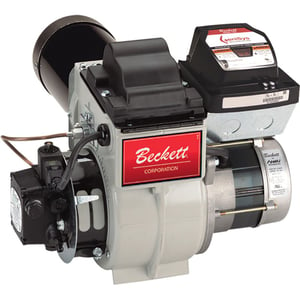As heating and combustion technology developed over the years, oil burner innovations have made today's system safer and more efficient than ever before. From the first oil burners until now, technological and engineering advances both big and small have improved oil burner performance in ways that benefit the customer as well as the service technician.
As each progressive burner design was replaced by the next, energy efficiency continued to increase and component engineering became more sophisticated, making oil burners capable of handling modern heating demands. In this post, we'll discuss the evolution of oil burner technology as well as the impact that those advancements have had on the heating system.
Oil Burner Technology Evolution
The earliest oil burners were designed to replicate a wood-fired burner. These "pot burners" started out with an uncontrolled open flame. These burners were most suitable for smaller applications, and though they still constitute one of the lowest operating costs of all oil burners, they have always been disadvantaged by their limited capacity.
Following the pot burner, the rotary burner was designed in order to convert coal-fired appliances to oil heat. Offered by a few manufacturers, the rotary burner was designed with a motor that spins and slings oil out into droplets that can be lit by the igniter. The rotary burner gave a quiet flame, but was still lacking in overall efficiency. However, this technology is difficult to use with modern heat exchangers, which restrict the flow of gases to transfer energy more readily. This incompatibility was the driving force behind the development of the power burner.
The power burner originally delivered a more robust flame than its predecessors, but the shape of the flame was still lazy, resembling a horse tail rather than a more directed flame. With some modifications, power burners were able to give a more sunflower-shaped flame. The benefits of the power burner included a more defined flame shape and position, so when fired into the appliance, it produced a more restricted power box area. Power burners were also installed with a fan to overcome the restricted passages of the heat exchanger for increased energy output as well as better heat efficiency.
Two main oil power burner technologies developed as a result of the original power burner design. Standard power burners were eventually replaced by flame retention head burners, which allowed the burner manufacturer to produce a burner that more easily matched the design of the appliance. This resulted in an increase of appliance efficiency from about 50-60% to about 70-80%. The flame retention head burner then became the platform for the next innovation, the blue flame burner. The blue flame oil burner used a different air tube which allows gas to recirculate and burn again, lowering emissions of nitrogen oxides. Though this fire was cleaner, the blue flame combined with more thorough combustion does run a higher risk of carbon monoxide leaks unless installed by a properly trained technician. Overall, power burners constitute the majority of oil burners in the heating market today.
 |
 |
| Click here to learn more about the AF/AFG Residential Oil Burner and other burners from Beckett. | Click here to learn more about the NX Residential Oil Burner and other burners from Beckett. |
Green Applications of Modern Oil Burners
As oil burner technology developed and continues to develop, engineers not only accounted for the performance of the burner but also the possible applications and benefits this new technology could provide. As the heating industry has begun to shift toward greener environmental standards all around, oil burners in particular have become up to 95% cleaner than they were only twenty-five years ago. Both flame retention head burners and blue flame burners burn cleaner when used with renewable bioblends and oils, giving oil heat the potential to become one of the most green heating options over the next several years. Power burners in general provide several other efficient benefits include multiple rates of fire, rapid heating and temperature maintenance, as well as some modulating technology that allows for more precise load management on large commercial applications.


